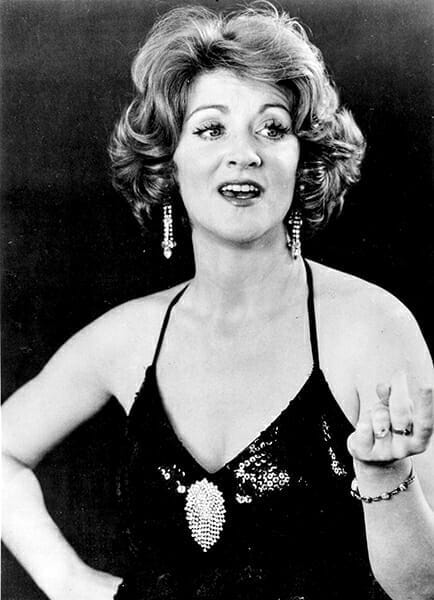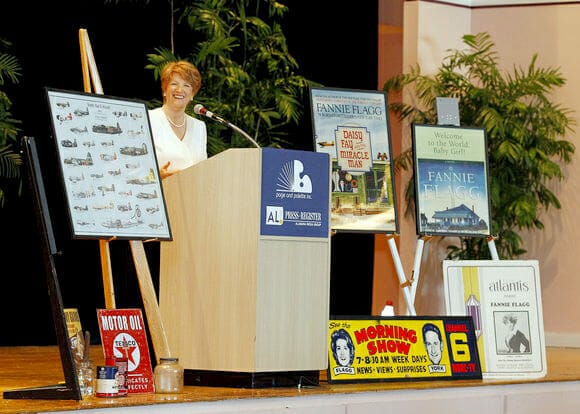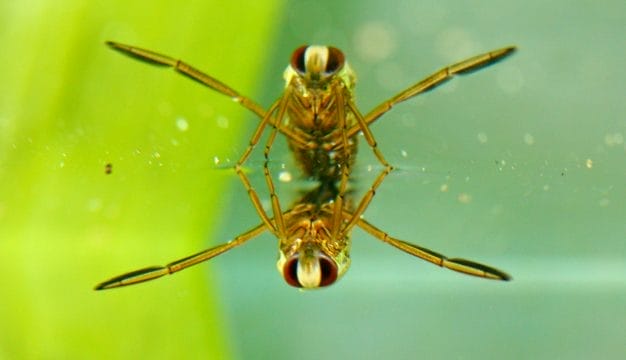Fannie Flagg
 Fannie Flagg
Fannie Flagg (1944- ) is an actress, comedian, producer, and bestselling author whose fiction focuses on small-town life (usually set in Alabama), with strong female characters who question racial and gender inequities. Her best-known work, Fried Green Tomatoes at the Whistle-Stop Café, was made into a critically well-received film.
Fannie Flagg
Fannie Flagg (1944- ) is an actress, comedian, producer, and bestselling author whose fiction focuses on small-town life (usually set in Alabama), with strong female characters who question racial and gender inequities. Her best-known work, Fried Green Tomatoes at the Whistle-Stop Café, was made into a critically well-received film.
Fannie Flagg was born Patricia Neal in Birmingham, Jefferson County, on September 21, 1944, to William H. and Marion Leona LeGore Neal; she was an only child. The family lived in Irondale, where her father was a businessman and movie theater projectionist. As a child, Flagg struggled with undiagnosed dyslexia and attention deficit disorder, which caused her to lack self-confidence as a writer for many years. She began acting at 14 with a Birmingham theater troupe for children and young adults, and she wrote skits in which she played the lead roles, most notably a play entitled The Whoopee Girls. At 17, when she registered with Actor’s Equity (a union for actors who work in live theater), she changed her name to Frances Carlton Flagg, which she shortened to Fannie Flagg, to avoid being confused with Oscar-winning actress Patricia Neal.
 Fannie Flagg, 1960s
Flagg attended the University of Alabama but left before completing her degree and then spent time at the Pittsburgh Playhouse where she wrote, performed plays and skits, and developed her craft. Upon her return to Alabama in 1964, she worked as a producer on the Morning Show on WBRC-TV in Birmingham. In 1965, she moved to New York, where she appeared at the Upstairs at the Downstairs nightclub. Her first break came with the sale of material for a skit, and she later did stand-up comedy there. Hired as a staff writer for Allen Funt’s Candid Camera television series, she worked on and off camera during 1966-67. She also appeared in The New Dick Van Dyke Show and Harper Valley. She was a guest star on multiple situation comedies and appeared in many movies, including Five Easy Pieces (1971), Stay Hungry (1976), and Crazy in Alabama (1999). Equally at home on the stage, she also performed in Come Back to the Five and Dime, Jimmy Dean, Jimmy Dean (1979) and The Best Little Whorehouse in Texas (1980) on Broadway. During her years as a working actress, she also was a frequent guest on game shows and talk shows. She recorded and toured to promote four comedy albums. Flagg also spoke out on behalf of the Equal Rights Amendment.
Fannie Flagg, 1960s
Flagg attended the University of Alabama but left before completing her degree and then spent time at the Pittsburgh Playhouse where she wrote, performed plays and skits, and developed her craft. Upon her return to Alabama in 1964, she worked as a producer on the Morning Show on WBRC-TV in Birmingham. In 1965, she moved to New York, where she appeared at the Upstairs at the Downstairs nightclub. Her first break came with the sale of material for a skit, and she later did stand-up comedy there. Hired as a staff writer for Allen Funt’s Candid Camera television series, she worked on and off camera during 1966-67. She also appeared in The New Dick Van Dyke Show and Harper Valley. She was a guest star on multiple situation comedies and appeared in many movies, including Five Easy Pieces (1971), Stay Hungry (1976), and Crazy in Alabama (1999). Equally at home on the stage, she also performed in Come Back to the Five and Dime, Jimmy Dean, Jimmy Dean (1979) and The Best Little Whorehouse in Texas (1980) on Broadway. During her years as a working actress, she also was a frequent guest on game shows and talk shows. She recorded and toured to promote four comedy albums. Flagg also spoke out on behalf of the Equal Rights Amendment.
 Fannie Flagg Novel
In 1978, Flagg won first place in fiction for a short story that she had written at the Santa Barbara Writer’s Conference. The work became the basis for the novel Coming Attractions. In 1980, after the deaths of her parents, she decided to pursue writing full-time. Flagg’s first novel, Coming Attractions: A Wonderful Novel, was published in 1981. The book was reissued as Daisy Fay and the Miracle Man in 1992. A coming-of-age novel set around 1952, it features an eleven-year-old protagonist, Daisy Fay Harper, who uses diary entries to tell the story of her alcoholic father’s get-rich-quick schemes and her ladylike and well-mannered mother. The book stayed on the New York Times bestseller list for 10 weeks.
Fannie Flagg Novel
In 1978, Flagg won first place in fiction for a short story that she had written at the Santa Barbara Writer’s Conference. The work became the basis for the novel Coming Attractions. In 1980, after the deaths of her parents, she decided to pursue writing full-time. Flagg’s first novel, Coming Attractions: A Wonderful Novel, was published in 1981. The book was reissued as Daisy Fay and the Miracle Man in 1992. A coming-of-age novel set around 1952, it features an eleven-year-old protagonist, Daisy Fay Harper, who uses diary entries to tell the story of her alcoholic father’s get-rich-quick schemes and her ladylike and well-mannered mother. The book stayed on the New York Times bestseller list for 10 weeks.
Her best-known and most successful novel, Fried Green Tomatoes at the Whistle-Stop Cafe, was published in 1987, remaining on the New York Times bestseller list for 36 weeks. It was praised by both Harper Lee and Eudora Welty. The novel is told in both past and present tense by the characters Ninnie Threadgoode (past) and Evelyn Crouch (present) and focuses on the town of Whistle Stop, Alabama, circa the 1920s and 1930s. It is about the unlikely bonds forged between women who seemingly have nothing in common except restlessness. Flagg, along with Jon Avnet, adapted the novel for a 1991 film of the same name. The screenplay was nominated for an Academy Award and won the University of Southern California (USC) Scripter Award from the Friends of USC Libraries and “Best Adapted Screenplay” from the Writer’s Guild of America in 1992.
 Fannie Flagg, 2013
Flagg’s later publications include works based on her novel about the Whistle-Stop Café, including Fannie Flagg’s Original Whistle-Stop Café Cookbook (1993) and The Wonder Boy of Whistle Stop (2020). Other works include Can’t Wait to Get to Heaven (2006), a satirical take on southern and small-town culture that centers on coming to terms with aging, what it means to have spent a lifetime in a community, and questioning how to best define happiness; I Still Dream About You (2010), a comedic mystery about a former Miss Alabama; and The All-Girl Filling Station’s Last Reunion (2013), a tribute to the women who served in the Women Airforce Service Pilots (WASPs) during World War II. Written in 1998, Welcome to the World, Baby Girl! is unusual for Flagg because it is a rare novel not set in the South. In it, Dena Nordstrom, the story’s lead character, is building a life in New York City while attempting to come to terms with her past in a small town.
Fannie Flagg, 2013
Flagg’s later publications include works based on her novel about the Whistle-Stop Café, including Fannie Flagg’s Original Whistle-Stop Café Cookbook (1993) and The Wonder Boy of Whistle Stop (2020). Other works include Can’t Wait to Get to Heaven (2006), a satirical take on southern and small-town culture that centers on coming to terms with aging, what it means to have spent a lifetime in a community, and questioning how to best define happiness; I Still Dream About You (2010), a comedic mystery about a former Miss Alabama; and The All-Girl Filling Station’s Last Reunion (2013), a tribute to the women who served in the Women Airforce Service Pilots (WASPs) during World War II. Written in 1998, Welcome to the World, Baby Girl! is unusual for Flagg because it is a rare novel not set in the South. In it, Dena Nordstrom, the story’s lead character, is building a life in New York City while attempting to come to terms with her past in a small town.
Flagg won the 2001 Alabama State Council on the Arts Distinguished Artist Award, and in 2012, she won the Harper Lee Award, which honors Alabama’s distinguished writer of the year. Flagg has homes in Fairhope, Baldwin County, and Santa Barbara, California.
Works by Fannie Flagg
Rally ‘Round the Flagg (sound recording, 1967)
My Husband Doesn’t Know I’m Making This Phone Call (sound recording, 1971)
Coming Attractions: A Wonderful Novel (1981) (Reprinted as Daisy Fay and the Miracle Man, 1992)
Fried Green Tomatoes at the Whistle-Stop Cafe (1987)
Fannie Flagg’s Original Whistle-Stop Café Cookbook (1993)
Welcome to the World, Baby Girl! (1998)
Standing in the Rainbow (2002)
A Redbird Christmas (2004)
Can’t Wait to Get to Heaven (2006)
I Still Dream About You (2010)
The All-Girl Filling Station’s Last Reunion (2013)
The Whole Town’s Talking (2016)
The Wonder Boy of Whistle Stop (2020)
Additional Resources
Flagg, Fannie. “The Truth the Heart Knows.” In The Remembered Gate: Memoirs of Alabama Authors, edited by Jay Lamar and Jeanie Thompson, pp. 35-38. Tuscaloosa: University of Alabama Press, 2002.



